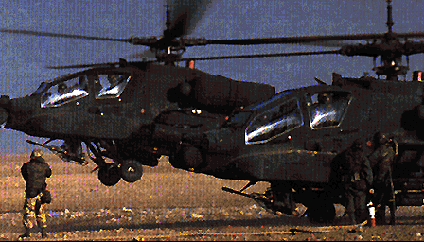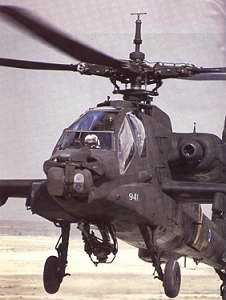

The AH-64A Apache was developed by McDonnell Douglas to meet a U.S. army requirement for a day/night all weather anti armour ground support attack aircraft with a high potential for survival in the battlefield. The
type's first flight took place on September 30th 1975, with production deliveries to the US Army beginning in January 1984. Taking a major part in the Gulf War, it has also been used in Panama, Somalia and other theatres of operation.
Israeli involvement with the Apache begun as far back as June 1983 when a prototype visited Israel for both evaluation of the helicopter's performance in desert conditions and for flight testing by Israeli pilots, testing which resulted in a recommendation to purchase the type to bolster the IAF's anti-tank capabilites. Despite misgivings within the IDF high command which prefered the acquisition of more Bell Cobras and new Sikorsky Blackhawks, in April 1989 the IAF announced its intension to purchase the Apache. $314 million were allocated for the 18 helicopters deal out of the U.S. military aid to Israel.
The first helicopters arrived on September 11th 1990, Israel being the first country outside the U.S. to operate the type. The delievery actually took place ahead of the expected date as the first export customer was Kuwait whose order was delayed when Iraq invaded on August 1990.
Having arrived a day before the planned welcoming ceremony, the first two examples were assembled in a record 11 hours, half the time recommended by McDonnell Douglas. The first IAF Apache squadron was the "Hornet" squadron which had formerly operated the Dassault Ouragan, IAI Nesher and IAI Kfir, and which is credited with 52 enemy aircraft kills. The Apache received the name "Peten", as the venemous Adder is known in Hebrew.
 The Apache was quickly put into active service and employed in southern Lebanon,
its first attack against suspected geurrilla positions taking place on October 24th 1991. On February 16th 1992,
as the motorcade of the Hizbullah secretary general made its way through southern Lebanon, it was ambushed and destroyed
by a pair of Apaches firing their Hellfire anti-tank missiles. The type has since routinely taken part in Israel's
operations against geurrillas in southern Lebanon, most notably in operation "Accountability" during July 1993 and operation
"Grapes of Wrath" during May 1996.
On the first day of operation "Grapes of Wrath", four Apaches attacked Hizbullah headquarters located in an apartment
building in mid-Beirut. Accurately firing their Hellfires through the windows of the apartment, they destroyed the Hizbullah
office, leaving the rest of the building intact.
The Apache was quickly put into active service and employed in southern Lebanon,
its first attack against suspected geurrilla positions taking place on October 24th 1991. On February 16th 1992,
as the motorcade of the Hizbullah secretary general made its way through southern Lebanon, it was ambushed and destroyed
by a pair of Apaches firing their Hellfire anti-tank missiles. The type has since routinely taken part in Israel's
operations against geurrillas in southern Lebanon, most notably in operation "Accountability" during July 1993 and operation
"Grapes of Wrath" during May 1996.
On the first day of operation "Grapes of Wrath", four Apaches attacked Hizbullah headquarters located in an apartment
building in mid-Beirut. Accurately firing their Hellfires through the windows of the apartment, they destroyed the Hizbullah
office, leaving the rest of the building intact.
In September 1992 the U.S. Ministry of Defence announced its decision to grant Israel 24 Apaches from U.S. Army stocks
and these aircraft arrived on September 12th 1993 to form the second Apache squadron. IAF Apaches have since undergone an upgrade
which included refurbishments to the engines, cannon, fire control and navigation systems.
On June 1st 1999 the IAF suffered its sole Apache crash when one of the helicopters which had undergone repairs crashed
during flight testing, killing the mechanic on board and slightly injuring the pilot.
In early 2000 the IAF announced its intention to covert 12 of of its AH-64As to AH-64D Apache Longbow standard. The 12 were
to undergo their conversion at a Boeing plant in Arizona, alongside US Army examples undergoing the same process. The deal
would have cost the IAF $400 million, with an option for 12 more helicopters to undergo the conversion as well.
Upon entering office in April 2000, however, the new IAF Commander, Dan Halutz, ordered a re-evaluation of the conversion
programme, opting for the purchase of brand new AH-64Ds intead. On February 19th 2001 Boeing announced that the Israeli
government had signed a letter of offer and acceptance with the US Department of Defence for the purchase of nine AH-64D
Apache Longbows. The value of the programme, which includes aircraft, ordance, spares, training and support is valued at
$500 million. It seems however, that plans to upgrade older A model Apaches have not been completely abandoned and several
IAF Apaches may be upgraded by Boeing yet.
Israel was only the second nation outside the USA (first being Holland) to be granted permission to operate the Longbow radar
and other upgraded systems available on the more advanced AH-64D. The Apache Longbow's rotor-mounted acquisition radar
allows the type to remain hidden while attacking enemy armour and affords the type increased weapons precision and
survivability compared to the AH-64A. The Longbow also features stronger engines and can simultaneously track 128 targets, presenting
the weapons operator with the 16 most important targets and immediate threats.
More about the Apache in Israeli service:
IAF Operations during Autumn 2000 Palestinian Uprising - A day by day account.
 back to the IDF/AF page
back to the IDF/AF page